In 1971, I acquired Brewood Hall. It was in a fairly sorry state but, having done what repairs and redecorations could be afforded at the time, it became my family home. Over the years, more extensive conservation and redecoration work has been carried out as possible.
I started to research the history of the Hall and produced a small pamphlet summarising my findings (printed using an obsolete type of stencil duplicator called a 'Gestetner'). Early in 2008, this information was transposed into the internet posting here. As time permitted, I've carried out more historical research, assisted by friends.
This post is a collection of more recent findings. Historical information frequently contains errors, for a variety of reasons. Transcription errors may occur - particularly with old documents. Many books 'borrow' from other sources, with or without acknowledgement, sometimes allowing errors to perpetuate. Writers should cite the sources for information quoted, so that readers can form a view as to its likely accuracy. I'm afraid this rigour has not (yet) been applied to these notes, in the interests of assembling the information I've come across in one place, but there is an informal Bibliography at the end. Brewood Hall was always a rather minor estate so not too much information is recorded. Little is known with complete certainty.
The Victoria County History (often referred to simply as 'VCH') was founded in 1899, dedicated to Queen Victoria, and intended as "an encyclopaedic record of England's places and people from earliest times to the present day". Since 1933, it has been based at the Institute of Historical Research, University of London, modestly claiming to be "without doubt the greatest publishing project in English local history." The VCH covers most of England and is organised on a county basis. Staffordshire (in which Brewood is located) is covered in 14 volumes! Brewood appears in Volume 5, covering the East Cuttlestone hundred (the 'hundred' is an archaic county division, described in Wikipedia here). Fortunately, a digital version of this information is available at British History Online which was founded in 2003 by the Institute of Historical Research and the History of Parliament Trust, to provide "a digital library of key printed primary and secondary sources for the history of Britain and Ireland, with a primary focus on the period between 1300 and 1800".
The index for the digital version of the 'A History of the County of Stafford: Volume 5, East Cuttlestone Hundred' is here. The two sections most relevant to Brewood are:-
Brewood: Introduction, manors and agricultureSome information is held at the Staffordshire Record Office and the William Salt Library, both located in Stafford.
Brewood: Churches, schools and charities
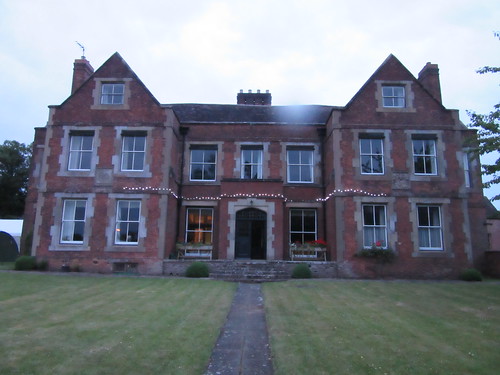 A summer evening at Brewood Hall in 2015.
A summer evening at Brewood Hall in 2015.
Miscellaneous Notes
Hearth Tax
In the Hearth Tax Assessment of 1666, Brewood Hall was assessed at 10 hearths. There's an explanation of Hearth Tax here. Roehampton University, London runs the Centre for Hearth Tax Research and they maintain an on-line database at Hearth Tax Online covering some parts of England (but not Staffordshire).
Gardens and Orchards
Brewood Hall was a 'manor peculiar' without extensive land. Until the 1960s, there were about six acres of gardens and orchards. Following the sale to a property development company, around 5 acres were developed for housing, leaving about one acre with the Hall. Dr. Plot visited Brewood Hall, writing in 1686 that "In the whitethorn hedge, between the garden and the court before the house, were the figures of several animals, castles, etc., formed in topiary, and that in the orchard there was the whitethorn figure of a wren's nest, big enough to hold a man. In the garden was a yew tree, which formed an arbor, measuring five yards square outside and three and a half inside, cut on the top with loop and crest, like the battlements of a town, adorn'd at each corner with a pinnacle, over which is wrought a canopy two yards in diameter, which is carried up gradually to a small pinnacle". Near the pale of the orchard was a "fine yew tree, cut up gradually from greater to lesser rounds, to the number of twenty".
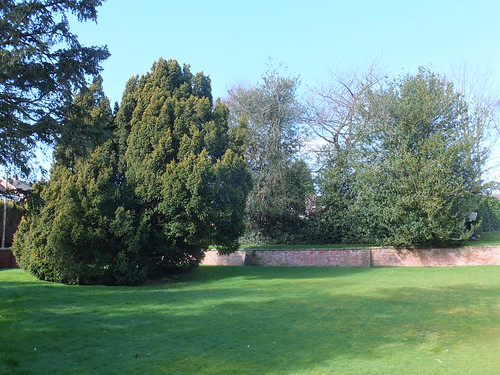 The Victorians swept away the topiary, but a massive, old yew tree still stands in remaining garden.
The Victorians swept away the topiary, but a massive, old yew tree still stands in remaining garden.
"The garden walls and gate pillars date from the late seventeenth century, as do some of the outbuildings. Stone fleurs-de-lis, about two feet high, which formerly surmounted each of the gate piers, are said to have been the origin of the mark used by John Turner, the famous Staffordshire potter, whose father once lived at the Hall. During the nineteenth century restoration, the fleurs-de-lis were removed to the back garden, and replaced by two large stone balls. On the north-east side of the Hall is a large early eighteenth century red brick farm building with king-post roof and exposed first floor beams. The building seems to have been used as a malthouse in the last century. The sandstone gateposts and steps of the former path to the rear of Brewood Hall still stand in Vicarage Road, a short distance from Sandy Lane. The house of Hall Farm Close stand on the site of a large pond which was filled in about 1960. The pond may have marked the site of Brewood Hall quarry, said to have been very deep, which was full of water before 1869." [reference 3].
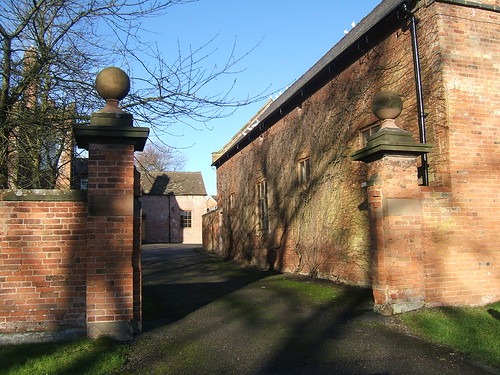 The main gate showing renovated gate piers with ball finials (prior to hanging of gates).
The main gate showing renovated gate piers with ball finials (prior to hanging of gates).
Period 1200 - 1786
Deer hunting was popular and King John is thought to have had a ‘Camera Regis’ (a temporary residence) on the site of Brewood Hall around 1204. The Fowke family became bailiffs of the Episcopal Manor of Brewood and Brewood Hall remained in this family for a number of generations. Brewood Hall was technically a 'Manor Peculiar' without extensive manorial lands. The Hall, gardens and orchards occupied only about six acres of land. "Brewood Hall is traditionally the site of King John's hunting lodge, and before the fourteenth century the semi-official residence of the bailiff of the Bishop's manor." [reference 3].
The pedigree of the Fowkes shows William Fowke living at Brewood Hall during the reign of Edward IV (1461-1483, with a brief interruption). During this period the ‘Leet’ (a Great Court) was held here.
Period 1786 - 1929
The Hall was owned by the Monckton's between 1786 and 1929 and the Turner family and others were tenants. In those times, landowners would often allow successive generations to be tenants, as long as the rent was paid.
Period 1929 - 1960
In 1929, Major R.P.F. Monckton sold Brewood Hall to Colonel C. O. Langley and it was the Langley family home for around 30 years. C.O. Langley was a partner in a solicitors practice (Fellows, Langley and Wright) in the town of Wolverhampton, about 8 miles from Brewood. He was also Borough Coroner and Stipendiary Magistrate in Wolverhampton. A son and daughter were brought up at Brewood Hall. Tragically, the son lost his life during the Second World War, whilst serving as a sub-mariner. His mother was unable to come to terms with the loss and became very reclusive. After the War, there were at least two part-time household staff. A housekeeper was accommodated in a modern cottage in Vicarage Road, about 5 minutes walk across the orchards which then lay at the rear of Brewood Hall. A gardner, handyman and chauffeur lived at Rambler Cottage, Sparrows End Lane, about two minutes walk from the Hall. Up until the 1960s, there was a substantial range of farm buildings next to Brewood Hall. Records indicate that Moncktons had an 'Estates Office' there in the 1950s, because they cite a fire at this office as the reason for not having the Title Deeds to a tract of disputed land in Coven.
Period 1960 - 1971
Following the death of his wife, C.O. Langley eventually decided to move to a smaller house in Wolverhampton. He disposed of Brewood Hall, with various outbuildings and the orchard, to Avion Properties in the 1960s. This company developed about five acres of the site for housing, resulting in the loss of some interesting buildings and all of the orchard, apart from one apple tree.
Until 1968, there was a large timber-framed barn with long straight braces to the lower panels. By the 1960s, it was in a very poor state of repair and, although there was an initiative to preserve the barn, it was not successful.
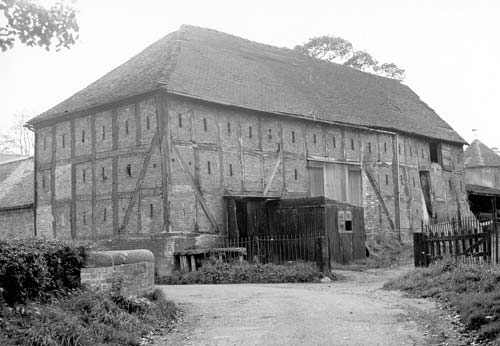 Large timber-framed barn at Brewood Hall, now demolished (Staffordshire Past Track).
Large timber-framed barn at Brewood Hall, now demolished (Staffordshire Past Track).
The photograph below is taken from 'The Turners of Lane End' [reference 5] and shows the setting of Brewood Hall as it was prior to the development in the 1960s. The Hall itself, on the left, is little changed in appearance today but the remaining buildings are either swept away or altered. The large Barn on the right of the drive remains, but the twin gabled building in the foreground was demolished, along with the part 2-storey/part 1-storey barn extending to the right. Tragically, the large timber-framed barn on the right was also demolished. The gable roof of another, long barn runs across the rear of the picture. Only the left end of this barn survives.
 Brewood Hall circa 1960 (from 'The Turners of Lane End').
Brewood Hall circa 1960 (from 'The Turners of Lane End').
The photograph below, circa 1966 shows site as the changes were being made. The twin gabled building has been demolished, revealing the interior rear wall abutting the large barn. On the right, the part 2-storey and part 1-storey barn has gone. In the background, the long barn can been seen, but this was subsequently truncated.
 Brewood Hall circa 1966 during partial demolition of the outbuildings (Staffordshire Past Track).
Brewood Hall circa 1966 during partial demolition of the outbuildings (Staffordshire Past Track).
This delightful hexagonal dovecote was also lost.
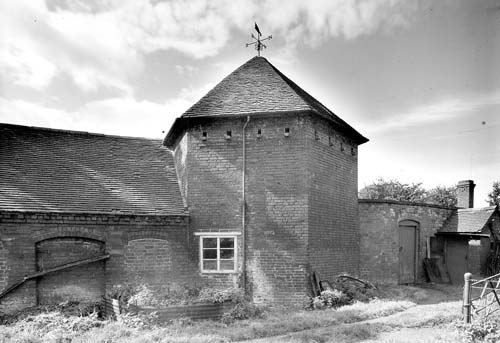 Dovecote at Brewood Hall, now demolished (Staffordshire Past Track).
Dovecote at Brewood Hall, now demolished (Staffordshire Past Track).
Brewood Hall, the 'Big Barn', the truncated barn (now dubbed the 'Little Barn' and the brick garden walls had all been designated as 'Listed Buildings, Grade II' and the developers were thereby prevented from carrying out further demolition. However, the property remained empty for some time and significant vandalism had occurred. I have no doubt that, before long, the buildings would have mysteriously 'gone on fire', had not the property been purchased.
Period 1971 - Present
The Hall and remaining Big and Small Barns, with around an acre of gardens, were acquired by J. C. Ford in 1971. We didn't get the original deeds on purchase as C.O. Langley's Abstract of Title was sufficient. The Hall was in part-vandalised condition, so the priority was to preserve the fabric and try to get at least part of the building habitable. My mother, a close family friend and I lived here and did the initial redecorations ourselves. In 1979 my partner joined us so there were four of us here. Over the next ten years my mother and family friend died and a difficult financial period allowed the house to become rather run-down but then my fortunes revived. I nursed my partner through a long illness until he died in 1999. I then set about conserving and redecorating the house with professional help and my hope is that this very special place can be kept in its present reasonable condition.
The Monckton family are still major landowners in the area. Stretton Hall is now the 'family seat' but they still own Horsebrook Hall and Somerford Hall.
The Giffard family have been in continuous occupation of Chillington Hall (but not the same building) since the de Giffards settled after the Norman Conquest.
Photograph References
For my pictures around Brewood, including pictures of some of the tombs in the churchyard, click here.
Pictures of the interior of the Parish Church and some of its memorials are here.
To give an idea of the extent of the village, there is also a series of pictures taken from the tower of the church. These are here. A further set of pictures was taken from the roof of Brewood Hall and these are here.
For Historic Pictures of Brewood Village, click here.
For Historic Pictures of Brewood Hall, click here.
Links
Brewood (Wikipedia).
Brewood: A Short History by David Horowitz).
Fooks and Fowke Family Trees.
GENUKO Brewood Parish Register - 1834.
Brewood Genealogical Records (Forebears).
Free British Ancestry.
Dustydocs.com (Australia).
Staffordshire, England Genealogy (UKIsearch.com).
Staffordshire Past Track.
References
[1] 'A History of the County of Stafford: Volume 5: East Cuttlestone hundred' (1959), Victoria County History
[2] 'Brewood' by Mary E. Wakefield, published in 1972 by Praill (Cannock) Limited.
[3] 'Brewood' by David Horovitz, (ISBN 1 85421 175 7).
[4] 'History and Antiquities of Staffordshire' by Stebbing-Shaw'.
[5] 'Master Potters of the Industrial Revolution - The Turners of Lane End' by Bevis Hillier.
